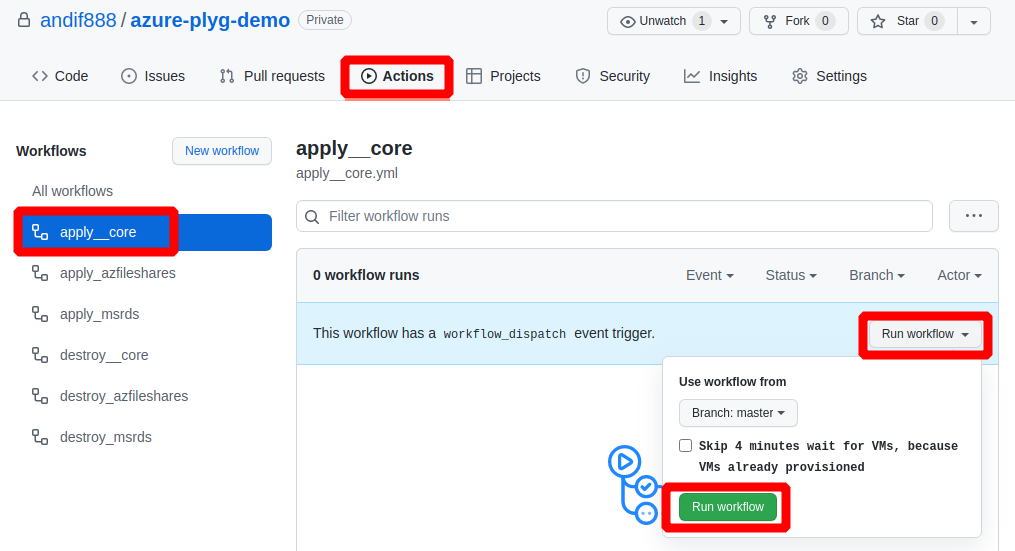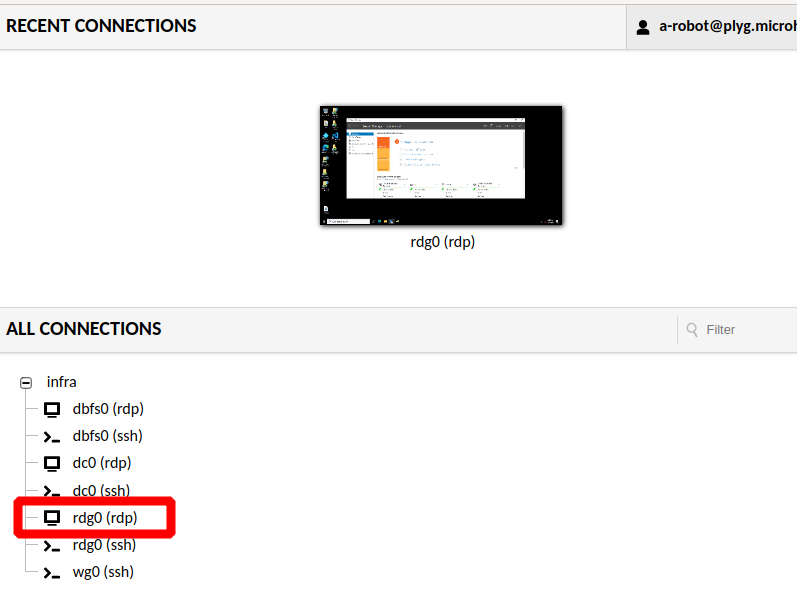This repo creates an azure playground environment. It provisions a few small infrastructure VMs to enable convenient remote access to the environment. The core environment automatically configures infrastructure services like Active Directory, Fileshares, SQL, Remote Desktop Gateway Remote Access including public SSL certificates.
The environment can serve any purpose but the many motivation is to automatically provision an environment which acts as your TestLab or HomeLab in the Azure cloud, which allows you ...
- ... to easily test software and configurations
- ... to have infrastructure services like Active Directory, Fileshares, SQL, Remote Access including public SSL certificates in place with one click.
- ... destroy and recreate everything anytime with one click
-
Windows Domain Controller (Windows Server 2022 Core)
Hostname:DC0
Active Directory gets automatically installed and configured. Also a bunch of users, groups and OUs are created. -
Microsoft Remote Desktop Gateway (Windows Server 2022)
Hostname:RDG0
A RDG gets automatically installed and configured with a valid and automatically renewed Letsencrypt certificate, to easily remote into your VMs using RDP. This machine has a Windows Desktop, because it's not Server Core and can act as managment VM. It has all the necessary RSAT tools installed to manage DC, DNS and so on. -
Windows File Server and SQL Server (Windows Server 2022 Core)
Hostname:DBFS0
Sooner or later every environments needs fileshares and some SQL and it's always tendious to set them up manually. -
Apache Guacamole (HTML5 RDG) (Docker Containers on Ubuntu 20.04)
Hostname:WG0
Accessing your lab using a webbrowser from any device is priceless. Gacamole gets fully configured, already containing all VM connections and fully integrated into Active Directory authentication.
All those infrastructure VMs are small Azure B1 and B2 vm-sizes and are intentionally configured with unmanaged disks in a Standard LRS storage account to keep azure costs at an absolute minimum.
Scaling it to powerful VMs with managed premium SSD or ephemeral disk for some good use-cases is easy.
-
You need an Azure Subscription
Maybe you have an existing one. Any subscription is fine. Even MSDN subscriptions or Azure Free Trials which come with USD200 azure credits are absolutely sufficient. -
You need an Azure Service Principal
The azure service principal needs to havecontributorpermission on your Azure Subscription.
Checkout: How to prepare a azure service principal. -
You need an existing Azure Storage Account
This is used for storing small terraform state files. Your azure service principal needs read/write access permission to this storage account. This storage account can be re-used for multiple environments.
Checkout: How to prepare the azure storage account. -
You need a public Domain Name at any Domain Hosting provider
This is used to make the environment your own. This enables you to access your environment using your own Domain Name. This can be any exisiting one. We only need to create two DNS CNAME Records, which acts like a subdomain. So no worry, we are not going to fuck up anything at your base domain. To understand why we need a reverse proxy dns hostname and a public hosting domain defined and how you choose the correct values, read the following:
Checkout: How to prepare your public Domain Name with DNS CNAME records -
You need a SSH Private Key in PEM format
All VMs are automatically configured with OpenSSH. Ansible is used as configuration management tool and it connects to your VMs using SSH tunneling which requires a SSH key in PEM format.
Checkout: How to prepare a SSH Private Key
Fork the repo. Take it. It must be yours. Is going to be your environment, not mine.
2. Adjust variables of sample.env
Copy the contents of sample.env to and editor and adjust the variables according to the pre-requisites. Adjust at minimum all mandatory variables.
Pay close attention when there is something like "must be unique". It's truely meant as must and not as can. So, change it!
If you cloned the repo locally and intent to run the build locally then copy the sample.env to .env and make your adjustments there. .env is in the .gitignore and will never be git pushed.
3. Create Github secret from your sample.env
Copy the complete content of your adjusted sample.env into a Github secret named envfile
Checkout: How to create envfile as Github secret
Copy the complete content of your SSH private key into a Github secret named TF_VAR_ssh_private_key_pem
Checkout: How to prepare a SSH Private Key
Click Actions, select the apply__core workflow and run the workflow.
In your webbrowser open https://guac.<value of TF_VAR_public_hosting_domain>.
Login with AD userPrincipalName:
Username: <value of TF_VAR_azure_vm_admin_username>@<value of TF_VAR_ad_domain_name>
Password: [value of TF_VAR_azure_vm_admin_password]
Under All Connection find and click rdg0 (rdp). Now you are logged in into your managment VM and you can look around.
There a currently 6 different workflows in Github Actions
3 Workflows are for provision and configuration. The other 3 are the corresponding ones to delete the resources.
This is the core workflow to provision the initial environment including Domain Controller, Guacamole, RD Gateway, Fileserver und SQL Server.
In general the workflow can be run multiple times. On each workflow run a new git tag is generated and the minior version number is incremented automatically. An new release is automatically created from the new tag. Your environment details are presented as release info in the Github repo.
This workflow provisions a complete Microsoft Remote Desktop Deployment. Before you run this workflow the core environment must already exist. This workflow installs:
- Remote Desktop Web Access
- Remote Desktop Connection Broker
- Remote Desktop Session Hosts
Valid SSL Certificates are automatically requested and installed. Host connections in Guacamole automatically added.
In general the workflow can be run multiple times. On each workflow run a new git tag is generated and the patch version number is incremented automatically. An new release is automatically created from the new tag. Your environment details are presented as release info in the Github repo.
This workflow provisions Azure Fileshare. It does only make sense to use this workflow as soon as you have implemented Azure AD Connect in your environment. To access Azure Fileshare corresponding AD Users must have been synced to AzureAD. As soon as Azure AD Connect is up an running you can use this workflow to provision Azure Fileshares. This workflow also handles the domainjoin on of the Azure Storage Account.
In general the workflow can be run multiple times. On each workflow run a new git tag is generated and the patch version number is incremented automatically. An new release is automatically created from the new tag. Your environment details are presented as release info in the Github repo.
If you want to teardown the whole environment, make sure to do it in the revers. If you have for example Azure Fileshare, the run destroy_azfileshares first before running the destroy__core workflow.
The same is true if you have uses provision_msrds. First use destroy_msrds before running the destroy__core workflow.



